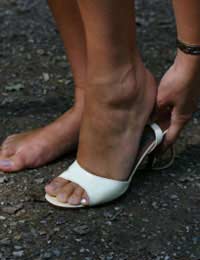Corns: the Causes and Treatments

When a bony prominence of the foot experiences continued pressure or friction from an opposing surface the tissues can become thickened and more tough resulting in a corn developing. They vary is size, shape and severity and tend to be more common in women, especially those who constantly wear tight or narrow shoes.
What Causes A Corn?
The most common cause of a corn developing is due to ill-fitting footwear, especially tight or narrow fitting shoes that cause the toes to become cramped into a small space where pressure builds up and friction between the shoe and the tissues of the foot occurs.Sometimes a deformity of the foot may be to blame, especially those with hammer toes or bunions as these condition force prominences to develop and increase the risk of some areas of tissue to feel pressure and rub against the shoe, when it normally wouldn’t.Signs And Symptoms
Most often seen on the top of the toes, corns can begin as areas of hard skin that become sore and red as the pressure on them continues. As they grow, the tissue can become discoloured taking on a greyish, brown or yellowing appearance. They usually appear as a circular area and sometimes a ‘root’ will be apparent towards the centre of the corn.They do often occur in other areas of the foot such as in between the toes or more rarely on the sole of the foot and can often involve nerve tissues that results in pain and discomfort.Treatment Options
The easiest way to reduce pain caused by corns is to change footwear and wear shoes that are wide enough to fit the foot comfortably. Frequent removal of footwear to rest the foot and allow it to relax and breathe will also help to reduce discomfort levels.Most people will benefit from using corn pads applied directly onto the affected area. These can be brought from many shops or chemists and aim to cushion the area prevent friction from occurring and reduce pressure. If you have any underlying medical illnesses such as diabetes or problems with circulation, always discuss your options with your GP or Practice Nurse as many corn plasters and pads are not recommend for use if these conditions are present.Use a pumice stone or other hard skin relieving device or lotion to try and soften the area and reduce the likelihood of it developing further. Treat any areas of hard skin appropriately before a corn can grow.
Visit a chiropodist who will be able to treat and advise on the cause of the corn and remove it gently be a series of treatments.
Never try to cut the corn away or ‘dig’ the root out yourself as this can be very dangerous leading to infections, bleeding and pain.
If hammer toes, bunions or another condition is to blame for the corns, see your GP who may recommend referral to a specialist to discuss options regarding the treatment of other conditions.
Corns are very common occurrences, but can cause many people a lot of discomfort, They are easily avoided if the correct footwear is chosen and if areas of hard skin are treated before they can develop into corns.
- Walking Aids: Braces & Splints
- Minimising Foot Swelling During Pregnancy
- How to Minimise the Risk of Blisters
- Combating Sweaty Feet
- Shin Splint Pain and Treatment
- Improving Heel Fissures
- What Are Heel Spurs?
- Peripheral Edema: Swelling in the Feet and Legs
- Webbed Toes and Treatment
- Fractured Calcanium
- Chilblains and Feet
- Bunions
- In-growing Toenails
- Athlete's Foot
- Blisters
- Calluses
- Verrucas


Re: Footcare and the Housebound
My dad is housebound due to 5 major strokes. He walks with a walker and wears a foot splint. The splint is old, heavy and no longer…
Re: Supportive Feet Products for Senior Citizens
I have a prescription from Dr. at OHSU, but I need some lab to make the Orthodic insoles for my shoes. I was…
Re: How to Get into Foot Modelling
I am female 32yrs of age.I am from south africa I would like to enter into feet and hands modelling industry .I know and I…
Re: The Benefits of a Paraffin Wax Treatment
Hi! Does it cure sweaty palm and feet too?
Re: I have Sharp Pains in My Foot, What could it be?
Recently I have been experiencing a stabbing pain in my left foot,its on the bottom at the back. When I…
Re: Fungal Infections of the Foot and Toenail
I have a constant problem with intense itching on my feet which erupts daily, especially when my feet get warm…
Re: Cosmetic Foot Surgery
I have extremely sweaty feet and it seems to be getting worse. I have perspirex, but it doesnt help. Please help, I don't know what to do…
Re: The Benefits of Foot Massage for Children
One day I came home and my wife said our younger son was having trouble concentrating on his homework. I asked…
Re: Cavus Feet: Symptoms, Causes and Treatments
@sue - I am sorry to hear this. As suggested in the article, arch supports or orthotic devices may be used to…
Re: Cavus Feet: Symptoms, Causes and Treatments
My daughter has cavus feet and has had surgery a few times already. Her surgeon has dismissed her and she is…